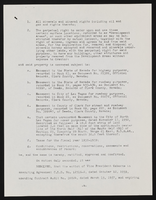Search the Special Collections and Archives Portal
Search Results
Audio clip from an interview with Treva Roles by Judy Harrell on February 12, 2014.
Date
Archival Collection
Description
Sound

Architectural drawing of addition to pavilion at Zion National Park, Utah, elevations, sections and details, December 12, 1925
Date
Description
Additions to pavilion building, Zion National Park, Utah. North and south exterior elevations, various interior elevations, numerous details, sections, plans and loading and stress diagrams for additions to the pavilion building at Zion National Park, Utah. Scales as shown. "Dr. by D.A.E., R.R.C., W.L.H. " "#15782-F. Sheet no. 6. Job no. 348. Date: 12/12/25." "Recommended by D.R. Hull per T.C. Unit, Landscape Eng. N.P.S. Approved by Stephen T. Mather, Director, N.P.S." "Rev. 1/11/26, 2/2/26, 3/2/26."
Site Name: Zion National Park (Utah)
Image
Jackson, Jerry
Born January 14, 1936 in Tulsa, Oklahoma, Jerry Reese Jackson has worked as a show producer, director, costume designer, choreographer, lyricist, and composer. In Las Vegas, Nevada, Jackson is best known for his work on the Folies-Bergère at the Tropicana Hotel and Casino where he served as artistic director, choreographer, and later as costume designer for nearly thirty-five years, beginning in 1975 and ending with the show's closure in 2009.
Person







